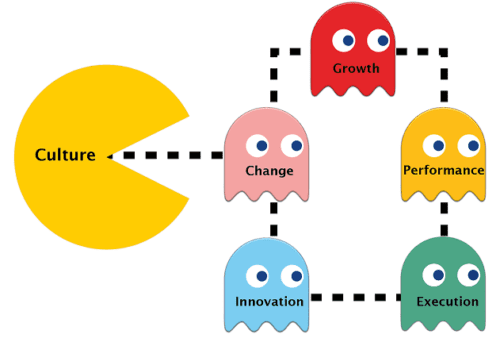
I was catching up on quite a bit of periodical reading recently. For me, this typically includes a wide range of sources ranging from HBR, CIO Magazine, Chronicles of Higher Education, Forbes, Fortune along with other interesting articles that pop up on LinkedIn.
I was surprised how there seems to be an abundance of articles about culture. Whether it was organizational or corporate culture, changing culture, assessing your culture – I could barely get through two or three articles before another culture-related article came up.
Now, I wish I could say that I am an expert in culture. I’m not. I am, however, an aficionado of culture. I love learning about an organization, usually about a prospective client, and getting the feeling that something really special is going on. Something intangible that seems to drive every person in the room forward. Maybe it is the buzz of a fast-growing startup or the energy around some recent transformation or breakthrough. But there is something in the air at these organizations, and it is more substantive than a “blinged out” office space or a cool logo.
The energy that is so hard to capture and define is similar to that you may experience when watching (or participating on) a sports team that surprises its fans with a come from behind win, especially, if it were one of your favorite underdog teams (Go Cubs!). Somehow, the teams have found a magical formula and pull off a victory when you least expect it.
Building on this, there are two scenarios that I am particularly intrigued by:
- A team that goes from “worst to first” in just one short year, or
- The team that is seemingly always at the top.
We all know that competition, both in and outside of the “business world” is hard. Market forces and economic cycles require more than just a change in plans and tactics. They require the DNA of an organization to change while balancing so many characteristics that will enable the organization to thrive during these volatile and competitive times.
So how do these “winning” organizations defy the odds?
As I was preparing to write this, I scoured quite a few sources of information and insight that I’ll share below to save you time. But, to get started, I will highlight the top factors that jumped out to me, pertaining to developing a winning culture. These may benefit you if you are looking to make a rapid turnaround or stay on top:
“But this time, without ever describing their efforts as ‘cultural change,’ top management began with a few interventions. These interventions led to small but significant behavioral changes that, in turn, revitalized Aetna’s culture while preserving and championing its strengths. And this point: Focus on a few critical shifts in behavior.“
Jon Katzenbach – Culture Change that Sticks
Often, we may hear about some initiative, originating out of a certain department and eyes roll and skepticism builds. However, the pragmatic focus on a few, small, but critical items that make a difference can begin to create momentum upon which larger change can be built on. Katzenbach’s perspective validates that we don’t need to take a “big bang” approach to culture change. In fact, perhaps “less” is “more”.
Know that valid self-analysis is crucial for improvement.
John Wooden – 8 Rules for Success
Few organizations really know, beyond, their financial performance, what their true operating performance or customer experience is like. Those that embed this self-analysis into their culture are rare and should be commended for investing in this area.
Critical “self-analysis” does not require bench-marking and can be very basic in nature. But starting with a solid baseline that defines, accurately and honestly, where the organization is – where it is thriving and where it is struggling – will serve as a natural and great platform to begin your improvement roadmap.
Turn the mundane into the sacred.
Coach Phil Jackson – 11 Principle’s for Mindful Leadership
At the risk of bringing culture “back to the basics”, think about some of the basic tasks we do all of the time:
- Have a meeting
- Serve customers
- Have “everyday interactions” with employees
- Transact business with vendors.
If these four items were primary inputs that one would use to define your organization’s culture, how would it be measured? Considering using these four areas within your span of responsibility to reinvent culture so that your organization becomes the organization you are proud of. Who knows – maybe it will rub off on other areas.
“Success is not all about talent. It’s about dependability, consistency, being coach-able and understanding what you need to do to improve.”
Bill Belichick, of the perennial favorite New England Patriots
When I get a chance to work with different organizations, I find it relatively easy to get a sense of how dependable, consistent and coachable an organization is, simply based on the senior leadership I interact with. If these three are absent, as you can predict, changing culture won’t happen. Change won’t happen. Great performance may happen, but likely only for a short term.
Think about your organization’s dependability, consistency and coach-ability and that will tell you a lot about the culture and readiness for change.
Hopefully, this article resonated with you. Feel free to pass this on to friends and colleagues. And for more like this, check out our other articles here.
Lastly, if your organization happens to have any potential project needs, please don’t hesitate to reach out to us here.
References:
- https://www.forbes.com/sites/davidrock/2019/05/24/fastest-way-to-change-culture/
- https://www.mckinsey.com/about-us/new-at-mckinsey-blog/want-to-reinvent-your-business-start-with-culture
- https://www.mckinsey.com/business-functions/mckinsey-implementation/our-insights/how-the-implementation-of-organizational-change-is-evolving
- https://hbr.org/2012/07/cultural-change-that-sticks
